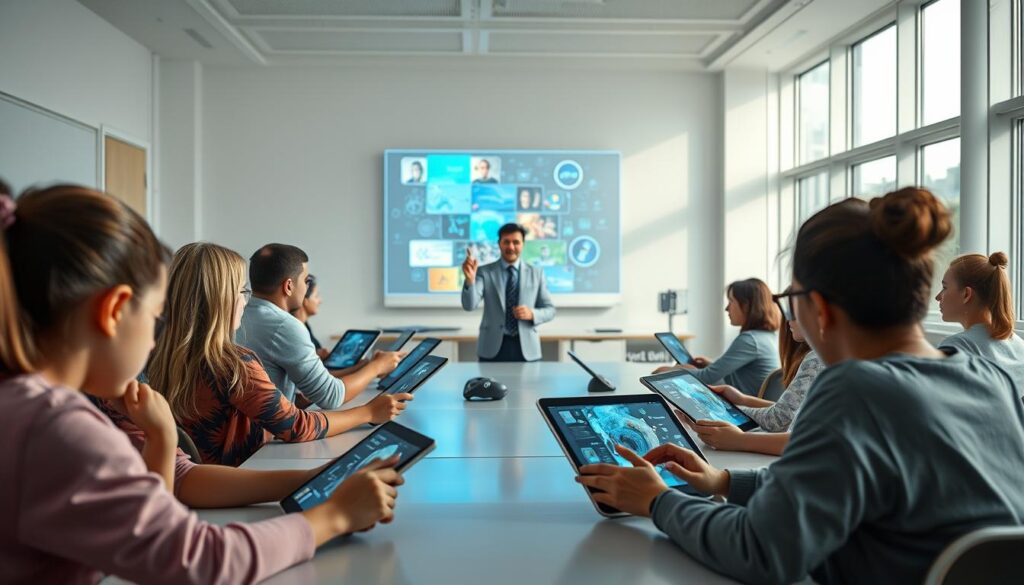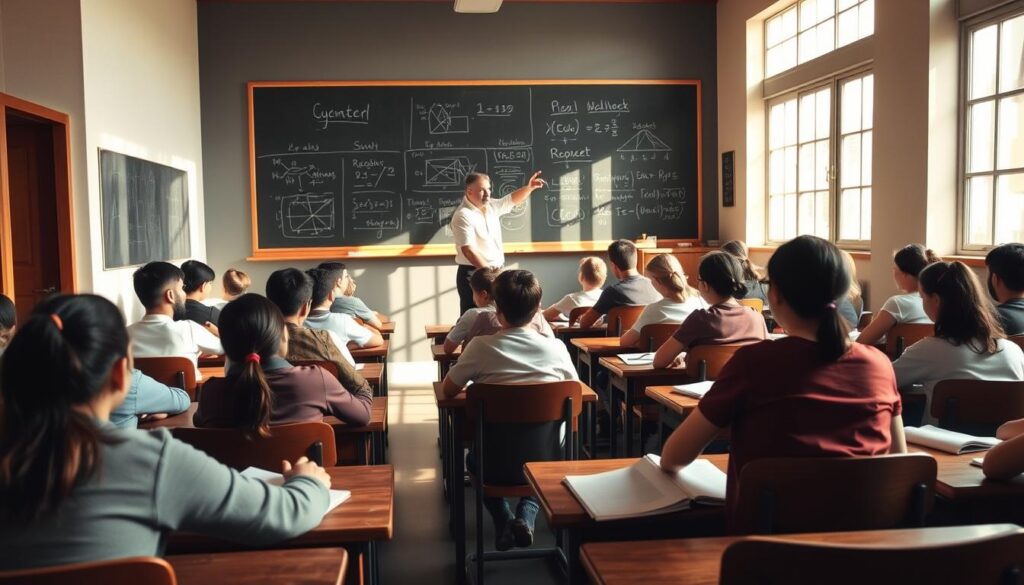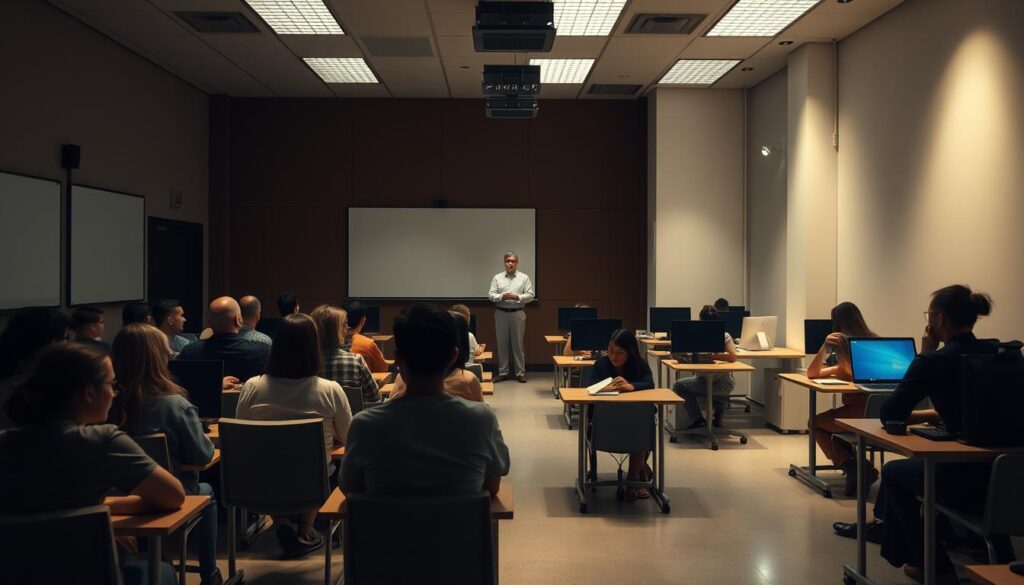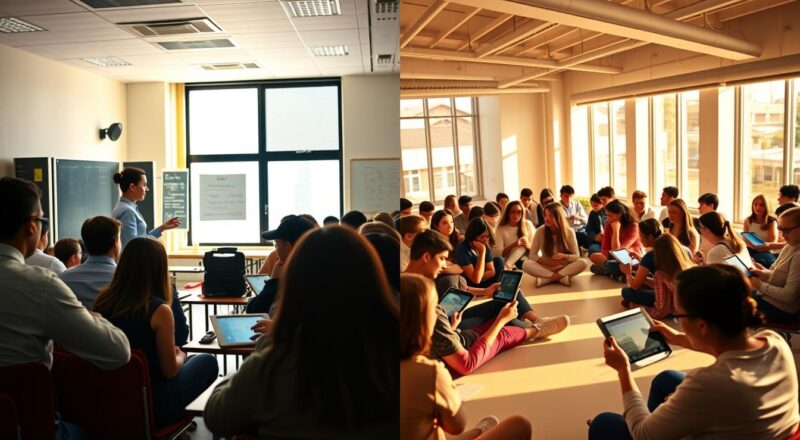As we explore new education trends, we always check how well different learning methods work. We compare microlearning and traditional learning, looking at e-learning needs and how to teach best today. Traditional learning has been around for a long time. It uses in-person classes to help remember things for longer. But microlearning is a new idea. It gives quick, easy-to-access lessons for today’s online, busy world. We need to decide which way of learning fits our goals and today’s learning style better.
- Key Takeaways
- Understanding Modern Learning Techniques
- Defining Microlearning and Its Core Components
- Traditional Learning Methods: A Closer Look
- The Main Differences: Microlearning vs Traditional Learning
- Microlearning Advantages: Why It’s Gaining Popularity
- Benefits of Traditional Learning in Depth
- Case Studies: Microlearning in Employee Training
- Interactive Learning: The Role of Technology in Microlearning
- Comparing Costs: Microlearning vs. Classroom-Based Learning
- Conclusion
- FAQ
- What are the key characteristics of microlearning?
- How does traditional learning differ from microlearning?
- What makes microlearning well suited for today’s fast-paced world?
- Can you explain how microlearning enhances engagement and retention?
- What are the benefits of traditional classroom-based learning?
- How has the role of technology influenced microlearning?
- Which is more cost-effective: microlearning or traditional learning?
- Why might some organizations choose a blended learning approach?
- What results have companies seen when implementing microlearning for employee training?
- Can microlearning be used for complex learning objectives?
Key Takeaways
- Educational methods are evolving to keep pace with rapid societal changes.
- Microlearning offers short, targeted sessions ideal for the digital age.
- Traditional learning focuses on extensive, in-depth knowledge sharing.
- Choosing the right strategy depends on the specific needs of the learners.
- Both microlearning and traditional courses have their roles in comprehensive education strategy.
Understanding Modern Learning Techniques
Education has changed a lot because of technology. Now we have modern learning techniques like online learning, digital learning, and blended learning. These methods are popular because they offer flexibility, efficiency, and easy access.
Evolution of Learning Methods
Before, education was just in classrooms. But technology has changed that. It has made learning interactive and personalized. Now, you can learn anywhere, anytime, thanks to digital tools. This supports blended learning.

Microlearning in Today’s Fast-Paced World
We all live fast lives and need quick learning. That’s why microlearning is getting popular. It gives you short learning bits. These bits fit well into our busy schedules using digital learning methods.
The Traditional Classroom Setting
Even with new learning ways, old-school classrooms are still important. They now use digital tools too. This mix of old and new makes learning better. It combines in-person teaching with online resources.
Today, we have so much information at our fingertips. Adopting new educational methods helps us learn better. Schools are keeping up with technology to meet students’ needs.
Defining Microlearning and Its Core Components
Microlearning focuses on quick and to-the-point learning bits tailored to what the learner needs right now. It stands out because it uses top microlearning techniques and microlearning strategies. This makes learning much more effective, especially when looking at microlearning in education.
- Bite-Sized Modules: Each learning piece is short, easy to manage, and direct, often taking just a few minutes. This helps learners keep the information better.
- Mobile-Friendly Platforms: Microlearning fits well in our mobile-first world, being accessible on phones and tablets. This offers more convenience and ability to learn anywhere.
- Interactive Elements: Adding quizzes and games, and giving real-time feedback, makes learning more interactive. This boosts engagement and helps students learn better.
- Personalized Learning Experiences: By using data analytics, microlearning systems can adapt to fit each person’s learning style and speed. This makes learning more effective.
Microlearning matches today’s lifestyles and tech, making education intuitive and within reach. With advanced microlearning in education strategies, teachers can hit learning goals efficiently and effectively.
![]()
Using microlearning basics enhances the learning path and cements its role in modern education worldwide. By diving deeper into microlearning strategies and microlearning techniques, we’re creating more dynamic, efficient, and tailored education systems.
Traditional Learning Methods: A Closer Look
In our look at different ways to learn, traditional learning methods are still very important. They mainly happen in classrooms. This way of learning helps students get into deep discussions, understand fully, and remember information for a long time.
The setting for traditional learning lets teachers and students work closely together. This kind of learning in person helps make sure students can think critically and solve problems in a group. It also makes sure students have a regular schedule and learn about topics in detail, which is good for remembering things well.

Let’s look at the table below. It shows the important parts of traditional learning that help students really get into their studies. These parts are key for remembering their lessons well.
| Feature | Description | Impact on Knowledge Retention |
|---|---|---|
| Structured Schedule | Regular, timed sessions within a classroom setting. | Encourages consistent learning habits and discipline. |
| Interactive Discussions | Teacher-led discussions that promote critical thinking. | Enhances understanding through clarification and debate. |
| Focus on Depth | Courses designed to cover topics extensively over longer periods. | Aids in forming strong foundational knowledge and skills. |
When we explore more about traditional learning methods, it’s clear they are really valuable. They focus on learning in classrooms and help students really grasp and hold onto their lessons. These key factors are essential for students to not just learn, but to fully understand their subjects.
The Main Differences: Microlearning vs Traditional Learning
When we look at microlearning and traditional learning, we see big changes in education. Traditional learning takes a lot of time and follows a set plan. Microlearning, however, offers small, easy-to-understand pieces that can be learned anytime.

The main differences between microlearning and traditional learning are how they teach and keep learners interested. Microlearning is short and varied, perfect for learning quickly. Traditional learning has longer study times. Being able to learn when it’s convenient is very important today.
| Feature | Microlearning | Traditional Learning |
|---|---|---|
| Duration | Short sessions (minutes) | Longer sessions (hours or days) |
| Flexibility | High (anytime, anywhere) | Low (fixed schedule, location) |
| Cost | Generally lower | Can be high due to physical resources |
| Content Delivery | Modular, bite-sized | Comprehensive, extensive |
| Pace | Self-directed | Set by instructor |
Looking at microlearning versus traditional learning, each style has its benefits. Microlearning is great for quick learning and busy schedules. Traditional learning is better for deep, formal education. Knowing the differences helps choose the best way to teach or learn.
Microlearning Advantages: Why It’s Gaining Popularity
Microlearning is making a big splash in education and job training. It’s known for its benefits and is quickly gaining fans among both organizations and individuals. Its flexibility, cost savings, and ability to keep learners engaged are why microlearning is becoming more popular.
Flexibility and Accessibility
Flexibility is a big plus of microlearning. It lets people learn at their own speed, anytime and anywhere. This makes it perfect for today’s hectic lifestyle. You can learn during a bus ride, a lunch break, or between meetings. Microlearning fits into daily life easily, making learning accessible no matter where you are.
Cost-Effectiveness of Microlearning Strategies
Microlearning is also cost-effective. It helps organizations cut down on training expenses. Since it needs fewer resources and less time to create, companies can use their money more wisely. They can spend on other important needs. This affordability is a major reason microlearning is attractive. It offers great value without sacrificing quality.
Enhanced Engagement and Retention
Microlearning stands out in how it boosts engagement and helps remember info. It uses fun elements like quizzes, infographics, and videos. This makes learning exciting and easy to remember. It suits the modern learner’s wish for interactive and dynamic content. This increases the chances of using what’s learned in real life.

Read more: Antiquantum Encryption in 2025: Essential Facts You Need to Know
Read more: What exactly is multimodal AI?
Read more: Top Digital Wellbeing Tools to Reduce Screen Time
Benefits of Traditional Learning in Depth
When we talk about traditional education vs microlearning, it’s key to see the advantages of traditional learning. Traditional education offers a detailed, systematic way of learning that’s crucial for understanding complex topics. Let’s dive deeper into these benefits.
Face-to-face interactions in traditional learning are unmatched. They create a perfect setting for deep talks and critical thinking. This is why traditional education is so important, even as we move more towards microlearning:
- Meticulous curriculum development ensures comprehensive education.
- The classroom setting boosts focus and participation.
- Immediate feedback from instructors clarifies and strengthens learning.
- Group work and peer interactions improve communication and teamwork.

Traditional education also comes from a long history and deep research, something microlearning is still catching up with. This rich background creates a learning atmosphere that’s sometimes missing in screen-based education. In conclusion, the structured and interactive nature of traditional education is key for both intellectual and social growth. It remains essential in our digital age.
Case Studies: Microlearning in Employee Training
Looking at microlearning case studies shows big trends in skill and knowledge growth. Organizations using microlearning for employee training see many benefits. They enjoy more flexible training, better memory of what’s learned, and quicker progress. This part shares examples and results of using microlearning.
Tech Innovators: A Shift Towards Microlearning
Top tech companies are choosing microlearning to make training better. They find its short, focused style ideal for the fast-changing tech world. Keeping up with new tech needs is key.
Corporate Training Outcomes with Microlearning
The effect of microlearning outcomes on training in companies is huge. Adding microlearning approaches has cut training costs. It has also boosted how much employees produce and how happy they are at work.

microlearning vs traditional
| Feature | Traditional Training | Microlearning Training |
|---|---|---|
| Time Efficiency | Long sessions spanning hours or days | Short, focused sessions taking a few minutes |
| Cost Effectiveness | High due to logistical and material costs | Reduced costs with digital distribution |
| Employee Engagement | Varies, often lower in long sessions | High, due to interactive and relevant content |
| Learning Retention | Lower retention due to cognitive overload | Higher retention from bite-sized information |
This comparison shows why more businesses choose microlearning for training. Microlearning fits the needs of modern workplaces well. It also helps with ongoing learning, which is vital in today’s fast market.
Interactive Learning: The Role of Technology in Microlearning
Interactive learning uses the latest technology to create a versatile and engaging educational setting. It makes learning more accessible and effective by using mobile devices and various multimedia. This approach changes how we learn today.
Learning can now happen anywhere, thanks to mobile devices. You’re not just stuck in a classroom anymore. This flexibility is key for people always on the move.
We make learning more fun by adding multimedia to microlearning modules. Think of videos, podcasts, interactive graphics, and games. These tools help meet different learning needs and make education enjoyable for everyone.
- Accessibility: Microlearning lets you learn on your terms, fitting education into your busy life.
- Engagement: Learning becomes more interesting with interactive content. It’s easier to understand, too.
- Retention: Using multimedia helps you remember information better. Methods include quizzes and interactive graphics.
Comparing Costs: Microlearning vs. Classroom-Based Learning
When looking at microlearning vs traditional learning costs, several key points stand out. Traditional learning often requires a lot of money for buildings, upkeep, and paying teachers. Microlearning uses technology to teach, which lowers costs and makes learning easier to get to.
In traditional learning, costs include classrooms, tools, and learning materials. These expenses don’t change much, so growing can be costly. Microlearning, however, takes advantage of digital learning cost benefits. It uses online platforms that are easy to expand without much extra cost.
Now, let’s do a deep dive comparison:
microlearning vs traditional
| Cost Factor | Traditional Learning | Microlearning |
|---|---|---|
| Initial Setup | High (physical space, equipment) | Low (digital platform setup) |
| Ongoing Costs | High (utilities, maintenance) | Low (minimal updates) |
| Scalability | Expensive (additional physical resources) | Economical (expandable digital content) |
| Flexibility | Low (fixed schedules and locations) | High (access anytime, anywhere) |
This comparison clearly shows the differences between microlearning vs traditional learning costs. The benefits of digital learning are significant. They’re especially attractive to those wanting a learning option that’s efficient, can grow easily, and is flexible.
Conclusion
When choosing effective learning methods, we need to look carefully at our options. Online learning offers flexibility and cost savings. It’s great for fitting into busy schedules. Microlearning stands out because it gives short, clear pieces of information.
Traditional classroom learning is still important for deep topics. It provides structure and the chance for live interaction. This is crucial for complex subjects or when building basic knowledge. The real choice isn’t about which method is better. It’s about picking the right approach for our needs.
Every learner is different. Today, we have many ways to learn, from microlearning to traditional classes. This variety lets us tailor our education. By thinking about what we want to achieve and our limits, we can mix methods. This ensures we learn effectively and thoroughly.
Outbound Links
microlearning vs traditional
-
https://www.td.org (Association for Talent Development – corporate learning insights)
-
https://elearningindustry.com (eLearning Industry – comparisons and resources)
-
https://edtechmagazine.com (EdTech Magazine – technology in learning)
-
https://www.classcentral.com (MOOC and online course aggregator)
FAQ
What are the key characteristics of microlearning?
How does traditional learning differ from microlearning?
What makes microlearning well suited for today’s fast-paced world?
Can you explain how microlearning enhances engagement and retention?
What are the benefits of traditional classroom-based learning?
How has the role of technology influenced microlearning?
Which is more cost-effective: microlearning or traditional learning?
Why might some organizations choose a blended learning approach?
What results have companies seen when implementing microlearning for employee training?
Can microlearning be used for complex learning objectives?
Get in Touch with SJ Articles
Read more: AI Writing Tools for Students: Top Picks
Read more: Artificial intelligence : What it is and why it matters in 2025
Read more: How to Set Up a Remote Office on a Budget


